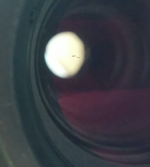@
[email protected] Sorry if the picture wasn't clear enough. The picture was taken looking from the objective side, so the white circle is simply light coming from the other side that allows you to see a hair (or something similar) on the inner side of the objective lens, which doesn't speak very well of the QC of Zeiss. The binoculars were just bought new in an authorised Zeiss seller. Needles to say, I wrote to the shop and they were exchanged for a brand new pair, but my point was that there is good and bad QC everywhere. Obviously, it will be better in a 500 $ pair, and usually better in a 1500 $, but we've even seen some +2000 $ with issues. I think that's the main issue with very cheap optics. If you manage to get a fine sample, that's great, because with current coatings technology you can enjoy a level of sharpness and contrast that is amazing for the price but:
a) don't expect it to last (especially the mechanical bits: focus wheel, hinge, eyecups)
b) don't expect it to be repaired at all
So, in a way yes, the old saying "you get what you pay for" usually remains true also in the QC department.
The 12x36 for me is quite a humbling lesson. The image quality is really flawed (CA, soft at times, etc.), the ergonoics are terrible, there's no waterproofing, etc. But I can ID more birds and come back home happy with new discoveries than with basically any other non-IS binoculars I can think of. It's such a game of balance between the terrible and the sublime that I somehow find it fascinating (is a bit like life itself! But enough waxing poetry about optics

).





